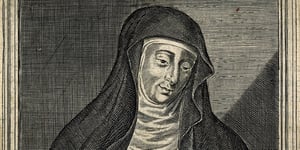“Everything that is in the heavens, on earth, and under the earth is penetrated with connectedness, penetrated with relatedness.”
—Hildegard von Bingen
"Glance at the sun. See the moon and the stars. Gaze at the beauty of earth’s greenings. Now, think. What delight God gives to humankind with all these things. . . . All nature is at the disposal of humankind. We are to work with it. For without we cannot survive."
—Hildegard von Bingen
St. Hildegard’s life story captures the admiration of many who read about her. The list of gifts and accomplishments of this 12th-century mystic, saint, composer, poet, healer, and Doctor of the Church is impressive. Originally, an interest in her musical compositions brought her to the attention of the modern world. St. Hildegard’s reputation grew further after she was officially canonized by Pope Benedict XVI in May of 2012 and declared a Doctor of the Church a few months later.
The Early Life of the “Sibyl of the Rhine”
Born in the Rhineland in 1098, Hildegard was the 10th child of a noble family. At the age of 8, she was placed in the care of a distant relative, the Benedictine anchoress Blessed Jutta. Some biographers claim that her ill health contributed to the family’s decision to dedicate her to the Benedictine monastery of St. Disibodenberg, but according to one source, her parents considered her their “tithe” to God. As for her health issues, from her own descriptions, it is likely that migraine headaches were the source of many of her symptoms. These bouts of illness were often accompanied by visions, many of them related to different perceptions of light. These began perhaps as early as the age of 3, but she kept them hidden for fear of being misunderstood.
St. Hildegard learned enough Latin to sing the Psalms but never learned to write. Despite lacking a formal education, in her lifetime, she developed a reputation for knowledge in many areas, including theology, music, and the medicinal use of herbs.
Hildegard’s Later Years and Mystic Visions Interpreted
Admired and trusted by her fellow nuns, when Blessed Jutta died in 1136, Hildegard was unanimously chosen to replace her as abbess. It was shortly after this she was commanded in a vision to write down the content of her visions:
"And it came to pass. . . when I was 42 years and 7 months old, that the heavens were opened and a blinding light of exceptional brilliance flowed through my entire brain. And so it kindled my whole heart and breast like a flame, not burning but warming . . . and suddenly I understood of the meaning of expositions of the books. . . "
Hildegard submitted her writings to her abbot, and through the bishop, they eventually made their way into the hands of Pope Eugenius III. He determined that the visions were genuine and encouraged Hildegard to continue her writing. With the help of a scribe, a Benedictine monk named Volmer, she produced three major theological works. In the first, Scivias (short for Scito vias Domini: “Know the Way of the Lord”), she describes 26 of her visions and her interpretation of what they mean. Around the year 1150, while writing this book, Hildegard founded a convent in Rupertsberg, near Bingen. (She founded a second convent just across the Rhine River in Eibingen in 1165, which still exists today. Hildegard was abbess of both convents.)
Hildegard on Health and Medicine
During the following years, 1150-1158, Hildegard composed her book on medicine and health, Liber Subtilatum (Book of Subtleties of the Diverse Qualities of Created Things), divided into two sections, her Physica (Medicine) and Causae et Curae (Causes and Cures of Disease). These books are considered unique, first because they were written by a woman, but are the only known books on health written in Europe in the 12th century. In the last years of her life, she composed two more books describing over 280 plants and their medicinal uses. Honey Meconi, considered an expert on Hildegard’s life and music, explains Hildegard’s understanding of health:
During the Middle Ages, monasteries had their own infirmaries and were places that people might go to if they were ill. So it’s natural for Hildegard to have known about healing. Also, as a Benedictine nun, she advocated and practiced moderation and balance—two things we recognize today as being important for well-being. She’s really one of the first people to write in such detail about healing and health, and she’s almost certainly the first nun to do so.
Hildegard and Her Musical Morality Play
During this time, she also wrote her musical morality play, Ordo Virtutum, considered by many to be the precursor to modern opera. According to one website dedicated to studying Hildegard’s works:
Ordo Virtutum plays on one of Hildegard’s fundamental concepts: divine forces conspire to support the human soul, eventually leading to fulfillment through spiritual cooperation. The soul can also conspire with evil and negative forces, though eventually we recognize the harm it brings us and return to divine forces to rescue us.
Her second and third theological works were written over the next 16 years. Liber Vitae Meritorum (Book of Life’s Merits) describes the continuous struggle between virtue and vice, considered by some to be a continuation of the themes found in Ordo Virtutum. In Liber Divinorum Operum (Book of Divine Works), Hildegard describes ten visions about the origins of the cosmos and how to think about nature as it relates to faith. Creation (nature) is God’s masterpiece; as mentioned, man is a microcosm of Creation.
Convents were often places of learning, with works of philosophy and theology available for study. The Benedictine rule requires that time be devoted to study, so it is very likely that she read widely. With the approval of her writings from Pope Eugenius, Hildegard’s reputation for learning and knowledge spread throughout Europe. We know from her 400+ letters that she was often consulted in religious and even political matters, corresponding with the likes of the German emperor Frederick Barbarossa (who told her that all of her prophecies concerning him had come to pass) as well as Henry II of England and his wife, Eleanor of Aquitaine. Many people wrote to her seeking advice on prayer and other spiritual matters.
Hildegard traveled widely in France and Germany, giving lectures at other Benedictine communities, but also, at the request of two Popes, she spoke in the cathedrals at Cologne, Trier, Liège, Mainz, Metz, Bamberg, and Würzburgand. This was most unusual for a woman at that time.
St. Hildegard’s Spiritual Vision: Interconnectedness between God, Man, and Creation
St. Hildegard regarded man as a microcosm of all of creation. Pope Benedict XVI reflects on this theme with these words:
Creation is an act of love by which the world can emerge from nothingness. Hence, through the whole range of creatures, divine love flows as a river. Of all creatures God loves man in a special way and confers upon him an extraordinary dignity, giving him that glory which the rebellious angels lost.
In St. Hildegard’s own words, from one of her compositions, O quam mirabilis, she prays:
O how wonderful is
the foreknowledge of the divine heart
that knew beforehand all creation.
For when God viewed
the form of the person whom he had made, he caught sight of
all his works, whole,
in the same form of the person.
O how wonderful is the inspiration
that thus awakened humanity.
For Hildegard, all of nature points to and reveals the Divine. In “Laus Trinitati,” she writes:
Praise to the Trinity
Which is sound and life,
And creator of all things
in their life,
and which is the praise of the angelic multitudes,
and the astonishing magnificence of the sacred mysteries that are unknown to humanity,
and which is the life in everything.*
*Translations by Honey Meconi
Hildegard’s Place in Musical History
Hildegard also has a notable place in the history of medieval music. The number of surviving compositions exceeds that of any other composer from the high Middle Ages.
According to Hildegard, before the Fall, a celestial song praised God continuously. Once the intimate connection between God and Man was interrupted, music remained man’s best hope for expressing his love for God and was essential for authentic worship of the Creator.
A recording of all her musical compositions is available on YouTube. Some people prefer the instrumental versions of her music, as in this example.
Pope Benedict XVI Praises St. Hildegard
What makes this saint so unique?
St. John Paul the Great in 1979 called St. Hildegard “a light for her people and her time.” It is with this quote that Pope Benedict XVI opens his Apostolic Letter proclaiming Hildegard of Bingen a Doctor of the Church. He continues with his own praise of her:
This great woman truly stands out crystal clear against the horizon of history for her holiness of life and the originality of her teaching. And, as with every authentic human and theological experience, her authority reaches far beyond the confines of a single epoch or society; despite the distance of time and culture, her thought has proven to be of lasting relevance.
*Cover Image: Hildegard von Bingen. Line engraving by W. Marshall / CC BY 4.0 via Wikimedia Commons / Cropped from Original

